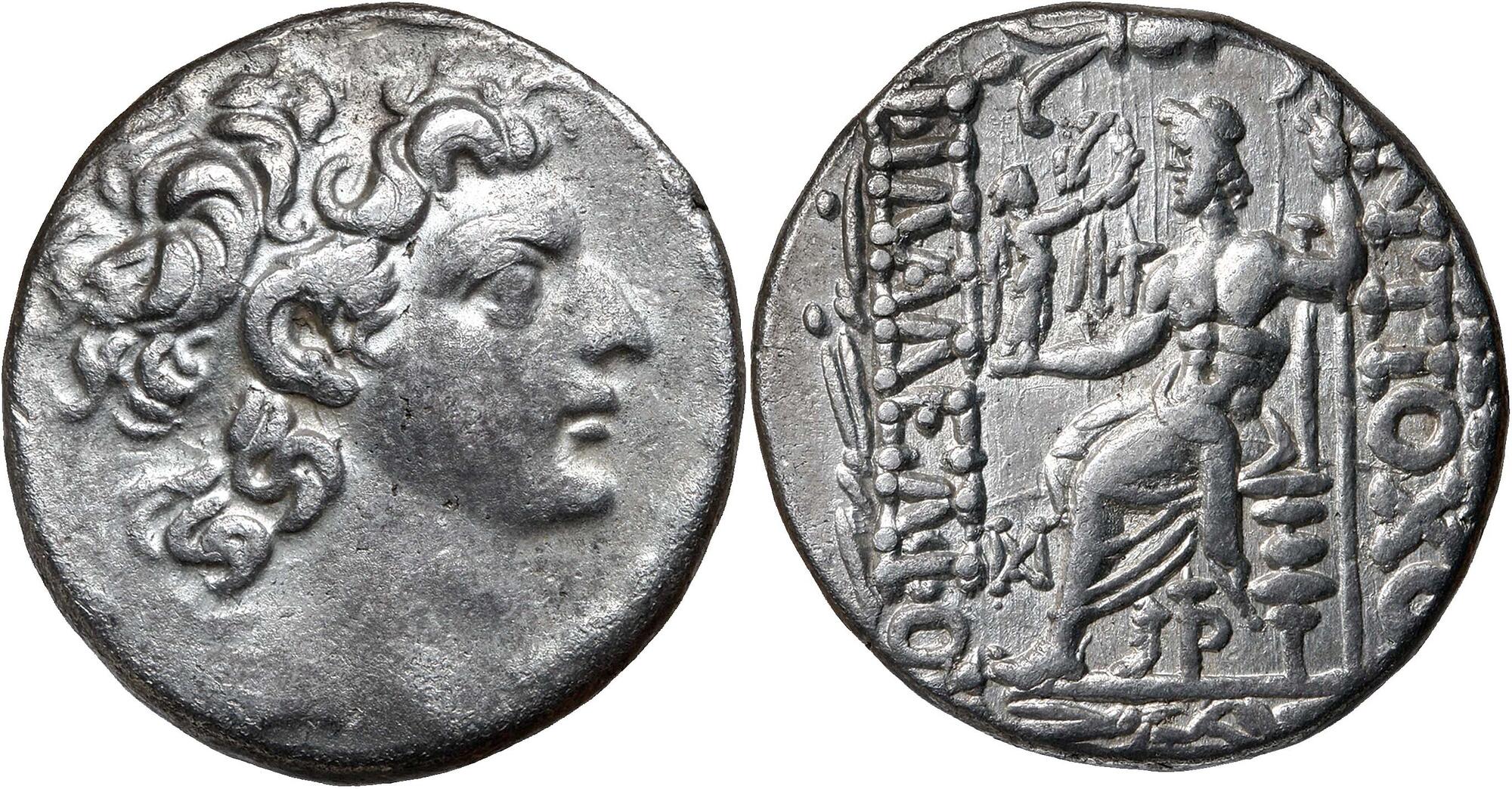Antioch (Antiochus XIII), silver, tetradrachms (65-64 BCE)
From SILVER
65 BCE - 64 BCE Silver 612 kg
Description
| ObverseInscription or printing placed on the obverse.: | Diademed head to right |
| ReverseInscription or printing placed on the reverse.: | BAΣIΛEΩΣ ANTIOXOV ΦΙΛΑΔΕΛΦΟV (Greek).Zeus Nikephoros seated left, XA monogram to inner left, P below throne, all within wreath |
Mint and issuing power
| MintIdentifies the place of manufacture or issue of a numismatic object.: | Antioch | Ancient regionAncient region.: | Syria | Modern countryModern country: Turkey | AuthorityIdentifies the issuing power. The authority can be "pretended" when the name or the portrait of X is on the coin but he/she was not the issuing power. It can also be "uncertain" when there is no mention of X on the coin but he/she was the issuing power according to the historical sources: | Antiochus XIII Asiaticus (Seleucid king, 69-64 BC), Seleucid Dynasty (312-63 BC) |
Chronology
| FromIdentifies the initial date in a range assigned in a numismatic context. | 65 BCE | toIdentifies the final date in a range assigned in a numismatic context.. | 64 BCE | PeriodTime period of the numismatic object.: Hellenistic 323-30 BC |
Physical description
| MetalThe physical material (usually metal) from which an object is made.: | Silver |
Median weightMedian of the weights of numismatic objects (in grams). in grams | 15.30 | DenominationTerm indicating the value of a numismatic object. Examples: tetradrachm, chalkous, denarius.: | tetradrachm |
StandardStandard.: | Attic |
Image

S1801 Antioch Antiochus XIII asiaticus.jpg [1]
References
| Die study referencePublication of the study: | Callataÿ 1997a1Callataÿ 1997a, p. 366 | ||
| Coin series referenceReference to coin series study: | Sear II2Sear II, n° 7213, SC II3SC II, n° 2487a, HGC 94HGC 9, n° 1340 | ||
Obverse dies distribution
| FrequencyFrequency of specimen in distribution. ᵖ | Number of obversesNumber of obverse dies. ᵖ (o) | % (o) | Number of coinsNumber of coins. (n) | % (n) | Die nameName(s) of the die(s). |
| 5 | 1 | 50 | 5 | 20.83 | 1 |
| 19 | 1 | 50 | 19 | 79.17 | 2 |
| Total | 2 of 2 | 100 | 24 of 24 | 100 |
Reverse dies distribution
no distribution is available
Quantification
| Number of obversesNumber of obverse dies. ᵖ (o) | 2 | Number of singletons (o1)The number of singleton coins. ᵖ | |
| Number of reverse diesNumber of reverse dies. (r) | 19 | Number of coinsNumber of coins. (n) | 24 |
| Coins per obverse dieNumber of coins per obverse die. (n/o) | 12 | Coins per reverse dieNumber of coins per reverse die. (n/r) | 1.26 |
| Reverse per obverse ratioRatio of obverse dies divided by reverse dies. (r/o) | 9.5 | Percentage of singletons (o1)number of coins (n) divided by the number of singletons (o1) ᵖ | % |
| Original number of dies (O) (Carter 1983 formula)The estimation of the number of coins according to Carter 1983 ᵖ | 2 | Coins struck if 20,000 as average productivity per dieCoins made if the average productivity for obverses (according to Carter) is 20,000. ᵖ | 40,000 |
| Original number of dies (O) (Esty 2011 formula)The estimation of the number of coins according to the singleton formula in Esty 2011 ᵖ (O) | 2.18 | Survival rate if 20,000 as average productivity per dieSurvival rate if average productivity is 20,000. ᵖ | 0.00060 |
| Coverage (o = % of O) (Esty 1984 formula)Esty 1984 - coverage (% of O) ᵖ (o = % of O) | % | Die productivity if survival rate 1/2,000Average productivity if survival rate is 1/2,000. ᵖ | 24,000 |
| Weight of silver (in kg) if 20,000 coins per die (O = Carter formula)Carter 1983 * Median weight * 20000 (*10 if gold or electrum) ᵖ | 612 kg <br /> 612 kg | Die productivity if survival rate 1/5,000Average productivity if survival rate is 1/5,000. ᵖ | 60,000 |
Remarks
Most likely one single workstation